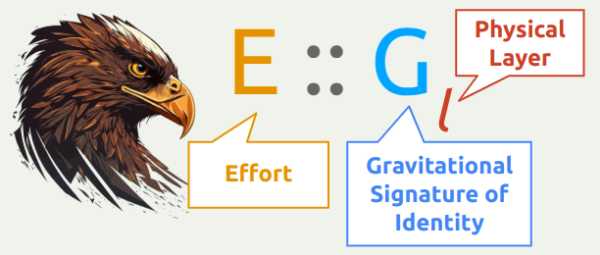The Eagle
Table of Contents
| Principles | Concepts Introduced |
|---|---|
| E = Gl | Kinetic, Potential |
Chapter 6d explained that the differences in the spins of identites, via their gravitational signatures of G, lead to relational effort.
- This manifests as relational action when actually deployed in reality.
The harmony or disharmony between spins leads to attraction and cohesion, or repulsion and disintegration.
This manifests as relational action which causes a thing to “gravitate” towards to, or away from, another thing.
This means that everything in existence has a G, whether it be a rock, a car, a virus, an opinion, a soul, a belief, a civilization, etc.
This G dictates its:
- relational movement, as kinetic energy, and
- relational pre-movement, as potential energy
We call:
- the kinetic energy as
For force - the potential energy as
Eor effort
We notate this as E = Gl. In Qualimath, this is E :: Gl

Eis inherent effort and represents potentialityGis the gravitational signature or dharma of the thing
We can call this equation as “eagle” as it is written with the letters E G l.
It predicts the movement of anything by knowing its G or dharma or true nature
relative to other G’s within the same layer and/or the immediate layer above it.
The Eagle Standard
The idea for the eagle came from the eagle standard of the Roman legions.

Historians wrote how the legions would rally around their eagle symbol and protect it with all their might. Our eagle equation is centered on G which represents Socrates’ true nature or dharma, which is a central belief in Buddhism, Hinduism, and Taoism.
Buddhists are urged to keep the wheel of dharma turning at all costs, just as Socrates’ guardians are supposed to keep up their mastery of true philosophy.
This is because if dharma or true philosophy stops, then society would likely degrade into selfish animal behavior and the love for matter (materialism) filled with vices, gambling, destruction, wars*, crises, etc. instead of love for the Aether (the material of mind of God)
Jan 2024
Update : The increase in wars in Ukraine, Israel, Middle East, and the threats from China and North Korea are proof that dharma has lost its momentum.This is why Superphysics is totally against Albert Einstein who not only reduced the aether to nothing, but also pushed for nuclear weapons which could lead to nuclear war. We place his intellectual ’evil’* on the same rank as the political evil of the other German, named Adolf Hilter.
*Our definition of evil is based on the strength of the ego
Rallying around the dharma and making an effort to keep it up would be similar to how the legions worked hard to secure their eagle from their barbarian enemies.
- In machines, this would be preventive maintenance.
- In healthcare, it would be maintaining a healthy lifestyle, as ‘prevention is better than cure’.
Dharma then leads to related concepts like sustainability, harmony, long happy lives, and making the idea of wars and crisis obsolete.
How to probe G
The job of knowing or discovering this G and predicting its movement-results is done by specific sciences:
For example:
- Biology looks into the nature of cells
- Physics looks into the nature of particles
- Metaphysics looks into the nature of souls and ideas
- Economics looks into the nature of goods and services
These sciences use the scientific method which involves the following steps:
- Observation
- Question
- Hypothesis
- Experiment
- Analyze the data
- Conclusion